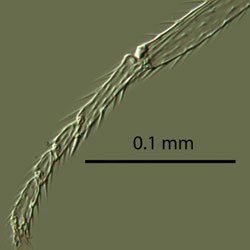Taxonomy

Encarsia formosa - mid tarsi 4-segmented.
Females are easily recognised by the following combination of characters:
- mid tarsi 4-segmented
- fore-wing uniformly hairy - without any evident bare patches
- body with head and mesosoma (thorax) black, metasoma (abdomen) bright yellow

Encarsia formosa - fore-wing is uniformly hairy.
E. formosa’s DNA has been sequenced for several different gene fragments, and these can be found on the Nucleotide, alphabet of life website with the following accession numbers: Mitochondrial: CO1: AY264337; Ribosomal:18S: AY918985; 5.8S and ITS1: AY615783; 28S: AY615760.
Polaszek et al (1992) included E. formosa in the complex of parasitoid wasps that attack the whitefly pest Bemisia tabaci.

Encarsia formosa - black head and mesosoma, bright yellow metasoma.
Because of its more or less cosmopolitan distribution, E. formosa is included in identification keys to Encarsia species from Australia (Schmidt and Polaszek, 2007); China (Huang and Polaszek, 1998); Egypt (Polaszek et al 1999); Mexico (Myartseva and Evans, 2007) and U.S.A. (Schauff et al, 1996).
Synonym: Trichaporus formosus (Gahan).
Toolbox
Glossary
Haemolymph
Fluid in the circulatory system of arthropods.
Olfactory
Sensory system for sense of smell.
Oviposition
Laying eggs using an organ called an ovipositor.
Thelytokous
Process by which female offspring are produced from unfertilised eggs.
Parasitoid
Depends on another species for survival, and kills it in the process.
